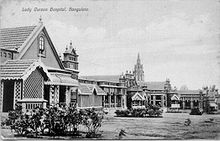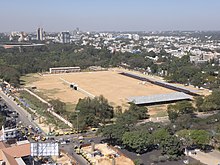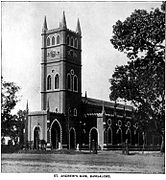Bangalore Cantonment
TheBangalore Cantonment(1806–1881) was a militarycantonmentof theBritish Rajbased in theIndiancity ofBangalore.The cantonment covered an area of 13 square miles (34 km2), extending from theResidencyon the west toBinnamangalaon the east and from theTanneriesonTannery Roadin the north to AGRAM (Army Group Royal ArtilleryMaidan -Maidanmeaning Ground) in the south. By area, it was the largest British military cantonment inSouth India.The Britishgarrisonstationed in the cantonment included threeartillery batteries,and regiments of thecavalry,infantry,sappers,miners,mounted infantry,supply and transport corps and theBangalore Rifle Volunteers.The Bangalore Cantonment was directly under the administration of the British Raj, while Bangalore City itself was under thejurisdictionof theDurbarof theKingdom of Mysore.
History and Layout
[edit]

Prior to the arrival of the British, Bangalore had been the stronghold of severalHindudynasties and empires including theWestern Ganga Dynasty,Chola Dynasty,Hoysala Empireand theVijayanagara Empire.In the 18th century, the dominion of Bangalore passed on toHaider Ali.After a series of successive wars known as theAnglo-Mysore Warswith Haider Ali's son,Tipu Sultan,the British captured the city and all of theKingdom of Mysorein 1799.
Capture of Bangalore Fort
[edit]Bangalore was the strongestfortof Tipu Sultan and during theThird Anglo-Mysore War,Lord Cornwallisdecided to reduce this fort before the storming ofSrirangapatna.[2]
Tipu Sultan followed Cornwallis' army, placing him in the awkward position of having an undefeated enemy army at his back while besieging the strong fortification. Tipu kept away hoping to take assault when underway in flank. Over the next twelve days, two companies of theMadras Pioneersprovidedsappersfor eight batteries, dug several parallels and a trench up to the fort ditch. Cornwallis attacked secretly on the night of 21 March 1791. The Madras Pioneers, led by LtColin Mackenzie,crossed the ditch with scaling ladders, mounted the breach and entered the fort, while the artillery engaged the fort with blank ammunition. With a breach made, the main stormers rushed in and the fort was captured after a hand-to hand fight in which a thousand defenders were killed. Cornwallis captured the fort and secured the force against Tipu.[2]
The Madras Pioneers, went on to make Bangalore their permanent home.
Establishment of cantonment
[edit]The British found Bangalore to be a pleasant and appropriate place to station theirgarrisonand therefore moved their garrison to Bangalore fromSrirangapatna.The origin of the wordcantonmentcomes from theFrenchwordcanton,meaningcornerordistrict.Each cantonment was essentially a well-defined and clearly demarcated unit of territory set apart for the quartering and administering of troops.[3]The heart of the Bangalore Cantonment was the Parade Ground. The Civil and Military Station (CMS) grew around the Parade Ground.

The installation of the Bangalore Cantonment attracted a large number of people fromTamil Naduand other neighboring states of the Kingdom of Mysore.[4]Bangalore rapidly became the largest city in theKingdom of Mysore.In 1831, the capital of the Kingdom of Mysore was moved from Mysore city to Bangalore. The Bangalore Cantonment grew independent of its twin-city, referred to as Bangalorepete(Kannada pronunciation:[ˈpeːteː]). Thepetewas populated with theKannadigapopulation, while the Bangalore Cantonment, had a colonial design with a population that consisted of Tamilians and the British. In the 19th century, the Bangalore Cantonment had clubs, churches,bungalows,shops and cinemas. The Bangalore Cantonment had a strongEuropeaninfluence with public residence and life centered on the South Parade, now referred to asMG Road.The area around the South Parade was famous for its bars and restaurants with the area known asBlackpallybecoming a one-stop shopping area[5]The Cubbon Park was built in the Bangalore Cantonment in 1864 on 120 acres (0.49 km2) of land. TheSt. Mark's Cathedralwas built on the South Parade grounds. The settlements adjacent to the South Parades was known asMootocherrywhich was occupied byTamilsettlers from theNorth ArcotandSouth Arcotdistricts of Tamil Nadu.

Development
[edit]The names of many of the cantonment's streets were derived from military nomenclature such asArtilleryRoad,BrigadeRoad,InfantryRoadandCavalryRoad.The city of Bangalore still retains many of the colonial names of its streets. A resident to the King of Mysore,Krishnaraja Wodeyar IVlived within the cantonment area and his quarters was called the "Residency"[citation needed]and hence the nameResidency Road.Areas around the South Parade that essentially were public living areas were named after their European residents. Amunicipal corporationwas established for the Bangalore Cantonment in 1863. AfterIndian independencein 1947, corporation merged with the Bangalorepetemunicipal corporation to form the Bangalore City Corporation, now known asBruhat Bengaluru Mahanagara Palike.Bangalore was part of theMadras Presidency,and in 1864, the city was connected toMadrasby rail. Still called the Bangalore Cantonment Railway Station, it is one of many railway stations servicing the city of Bangalore.[6]Around 1883, Richmond Town, Benson Town and Cleveland Town were added to the cantonment. The population of the Bangalorepeteand cantonment fell dramatically in 1898 when abubonic plagueepidemic broke out. Theepidemictook a huge toll and many temples were built during this time, dedicated to the goddess Mariamma. The crisis caused by this epidemic catalyzed the improvement andsanitationof Bangalore and, in turn, improvements in sanitation and health facilities helped to modernize Bangalore. Telephone lines were laid to help coordinate anti-plague operations. Regulations for building new houses with propersanitationfacilities came into effect. A health officer was appointed in 1898 and the city was divided into four wards for better coordination and theVictoriaHospital was inaugurated in 1900 byLord Curzon,the thenViceroyandGovernor-Generalof British India. In 1881, the British officially stopped recognizing Bangalore as a cantonment and instead considered it to be an "assigned tract", and administered under the auspices of theMahārājahof Mysore,Krishnaraja Wodeyar IV.However, the British retained their garrison in the city until 1947. After Indian independence, Bangalore Cantonment was merged with the rest of Bangalore City under the dominion of theMysore State.
-
St Andrews Kirk,Bangalore around 1895 - Furneaux, JH (1895) Glimpses of India. A grand photographic history of the Land of Antiquity, the vast Empire of the East
See also
[edit]- Cox Town, Bangalore
- Cooke Town
- Fraser Town, Bangalore
- Murphy Town, Bangalore
- Austin Town
- Kingdom of Mysore
- Sir Mirza Ismail
- Bangalore East Railway Station
- Bangalore Cantonment railway station
- List of areas in Bangalore Cantonment
- List of schools in Bangalore Cantonment
- Plaza Theatre (Bangalore)
References
[edit]- ^"The Cantonment Side of Bangalore".Chronicles of the London Missionary Society.1890.Retrieved2 November2015.
- ^abSandes, Lt Col E.W.C. (1933).The Military Engineer in India, Vol I.Chatham: The Institution of Royal Engineers. pp. 163–165.
- ^The Story of a City, East West Books (Madras) Pvt. Ltd., Jayapal Maya
- ^Destination: Bangalore.Bangalore Information
- ^St. John's Church, Bangalore, India
- ^http://hdl.handle.net/10919/9941Archived5 June 2012 at theWayback MachinePublic space in Bangalore: Present and Future Projections

